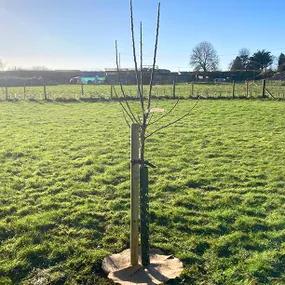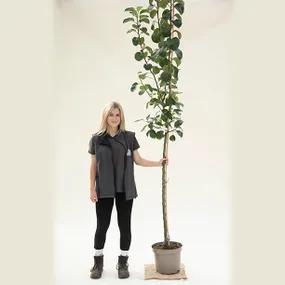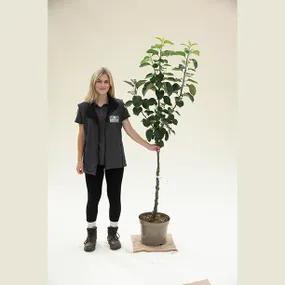'Bramley' Apple Trees

The details
- Cooking: Bakes to a soft puree. Tangy sweet-sharp flavour.
- Partial Tip bearer.
- Not self-fertile.
- Not pollinator (Triploid).
- Pollination Group D.
- Crops in early Oct. Stores till March.
- RHS Award of Garden Merit
Recommended extras
Description
Bramley's Seedling Apple Trees
Bramley Apple trees produce the most popular cookers. These are great big, flat-bottomed apples, usually with a rusty coloured, striped flush. The white flesh is the most acidic of British cooking apples; a raw Bramley apple contains about 2.5 times more vitamin C (ascorbic acid) than the average.
Bramley Seedlings have a distinctive, sharp flavour that mellows with storage so that by spring they are almost tart dessert apples. Freshly picked, they juice very well indeed and mixed with other apple varieties, it makes excellent apple juice - go for about 70% Bramley's, 30% sweet varieties. It is also added to many ciders.
Few other cooking apples bake so easily into the deliciously light, fluffy, syrup infused purée that is the ideal cooked apple - the flavour is mouth wateringly tangy and fruity and the texture is simply perfect.
They are very vigorous, heavy cropping and are ready to pick in early October. They are partial tip bearers and so only need pruning to keep them open and to remove dead wood.
Browse our other apple trees or read our guide to buying the right apple tree.
Features:
- Use: Cooking. Bakes to a puree. Superb flavour.
- Partial Tip Bearer: not ideal for cordons & training on wires.
- Tree's Growth Habit: Strong vigour. Spreading habit.
- Harvest: Early October
- Store & ripen in a cool, dry place: Until March.
- RHS Award of Garden Merit
Rootstocks for Bramley apple trees:
All of our Bramley trees are grown on MM106 rootstocks except bushes which are on M26.
Pollination Partners for Bramley:
Bramley is a self sterile triploid in Group D: its flowers must be pollinated by other apple trees in pollination Groups C, D and E to make any fruit and it cannot pollinate other trees. Use our interactive Guide to Apple Tree Pollination for a full list of partners & more tips about pollination.
Planting Instructions
Notes on planting Bramley trees:
All fruit trees like a rich soil with decent drainage and plenty of sun. Apple trees love clay soil as long is doesn't become waterlogged.
Bramley isn't suitable for frosty sites and may crop poorly in the North & Scotland, as its flowers are easily damaged by late spring frosts.
Prepare your site before planting:
Improving the soil in advance of planting your apple trees will help them establish quickly and be productive for years to come. After you have destroyed all the weeds and grass, you can dig the soil over. Remove any stones and rubbish and mix in well rotted compost or manure down to the depth of about 2 spades. You can do this on planting day, but when you do it weeks or months in advance, you will give the soil time to settle again.
Watch our video on how to plant a fruit tree for full instructions on planting a bush or half-standard sized tree.
If you are growing a maiden sized apple tree into a freestanding tree, a bamboo cane is enough support.
Remember to water establishing apple trees during dry weather for at least a year after planting.
Apple Tree Planting Accessories:
For bush and half standard apple trees, our tree planting pack includes a wooden stake & rubber tie to support the tree and a biodegradable mulch mat with pegs, which protects the soil at the base of your tree from drying out and stops weeds from sprouting.
We recommend using mycorrhizal "friendly fungi" on the roots of all new trees, especially if your soil is poorly fertile.
Did You Know?
Known by all as a Bramley, the proper name is Bramley's Seedling.
The tree was raised from a seed in 1809 by Mary Ann Brailsford, a young girl at the time (undoubtedly with help from her mum), with no record of its parents.
The house (75 Church Street in Southwell, Nottinghamshire - now owned by Nottingham Trent University) and garden were later bought by a Mr Matthew Bramley, and the tree was first raised commercially by Mr Merryweather's Nursery in 1865.
The original tree was cared for by Miss Nancy Harrison for some 70 years between the end of WW2 and 2014, passing the torch on to Nottingham Trent University.
It was hit by lightning in the early 1900's and fell over, but shrugged off the damage and re-rooted itself.
However, at the time of writing, it is not long for this world: it contracted honey fungus in 2016, but as of 2022 the tough old girl was still fruiting.
In a sense, all Bramley trees are the original because they are propagated through grafts, which mean they are clones of their parent (above ground, at least).
The RHS awarded it a first class certificate in 1893.

 1.webp)
 1.webp)


 3.webp)
 2.webp)
 with honey bee 4.webp)
